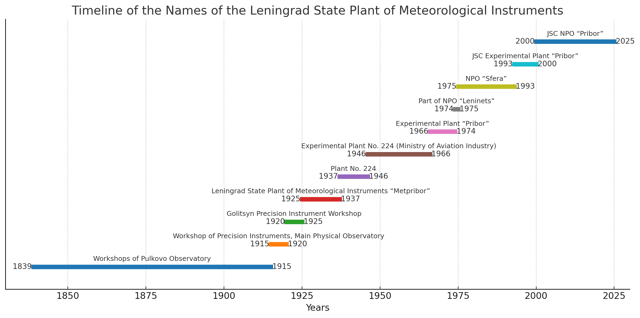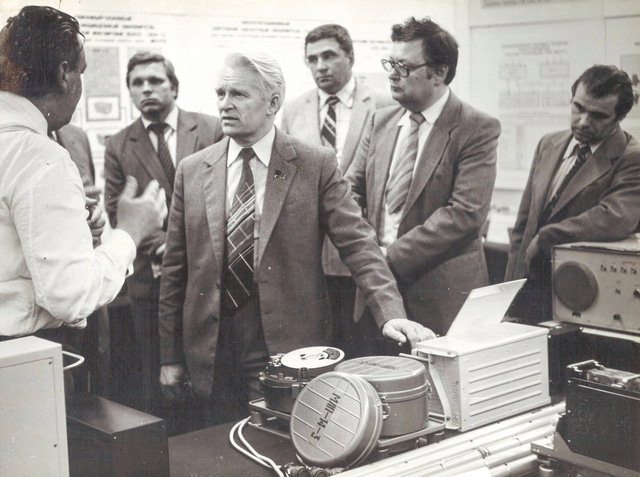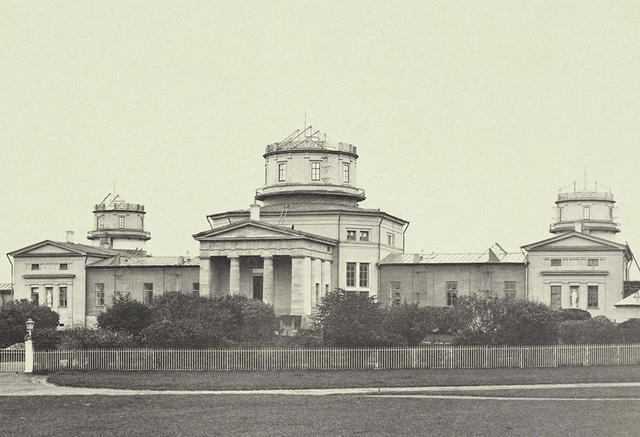


The history of the Leningrad State Plant of Meteorological Instruments (Ленинградский государственный завод метеорологических приборов, ЛГЗМП) can be traced back to the pre-revolutionary period. As early as 1839, mechanical workshops were organized at the Pulkovo Observatory in St. Petersburg for the manufacture of meteorological instruments. The direct predecessor of the plant was the precision instrument workshop of the Main Physical Observatory, created in Petrograd in 1915. After the October Revolution, this workshop went through a series of institutional transformations: in 1918 it became part of the cluster of precision instrument and watchmaking enterprises under the Metal Section of the Supreme Council of the National Economy (Высший Совет Народного Хозяйства, ВСНХ), in 1921 it was transferred to the Main Directorate of Precision Mechanics (Главточмех) of the ВСНХ, and from 1923 it was subordinated to the North-West Industrial Bureau. Between 1920 and 1925 the workshop bore the name of the prominent scientist Boris Golitsyn.
In 1925 the Golitsyn workshop was reorganized into an independent enterprise, the Leningrad State Plant of Meteorological Instruments “Metpribor.” Initially the plant was placed within the Trust of Optical-Mechanical Production of the ВСНХ of the RSFSR. In 1927 it was allocated premises in former barracks on Vasilyevsky Island, and after their conversion the country’s first State Plant of Meteorological Instruments was opened in November 1927 on the 17th Line of Vasilyevsky Island. This moment marked the birth of “Metpribor” as the main production site in Leningrad.
During the late 1920s and 1930s the plant passed through several changes of ministerial subordination, reflecting the restructuring of Soviet industry. In December 1930 Metpribor was transferred from the trust into the All-Union Association of Optical-Mechanical Industry (ВООМП). In 1931 it was reassigned to the All-Union Association of Precision Industry (ВОТИ) of the ВСНХ. After the liquidation of the ВСНХ in 1932, the enterprise came under the People’s Commissariat of Heavy Industry (Народный комиссариат тяжёлой промышленности, НКТП). In December 1936 it was moved into the People’s Commissariat of the Defense Industry (НКОП). In early 1937, in accordance with the general practice of secrecy and standardization, its name was changed: Metpribor became Plant No. 224. At the same time, by government order the plant was included in the 10th Main Directorate of the НКОП, and its new charter was approved. In January 1939 Plant No. 224 was transferred to the newly established People’s Commissariat of the Aviation Industry (Народный комиссариат авиационной промышленности, НКАП).
Throughout the 1930s the Leningrad plant continued to produce traditional equipment for the Hydrometeorological Service (barometers, hygrometers, anemometers), but increasingly focused on the needs of aviation. It mastered the production of aviation instruments, such as altitude recorders and airspeed measuring devices for aircraft. By the end of the decade, the plant had released the first Soviet recorders of speed, altitude, and pressure, which were indispensable for the rapidly developing domestic aviation sector. Thus, on the eve of the Second World War, the plant played an important role both in meteorology and in supplying the air force with precision instruments.
With the outbreak of war in 1941, Plant No. 224 was caught in besieged Leningrad and was partially evacuated. By decree of the State Defense Committee (Государственный комитет обороны, ГКО), about 80% of its equipment and staff were sent east – mainly to the city of Molotov (now Perm) and partly to Kazan. In Kazan, the evacuated Leningrad workforce was incorporated into the new Plant No. 448 of the НКАП, effectively created on the basis of Metpribor. However, full evacuation was impossible: a group of specialists remained in Leningrad and continued to produce urgently needed products on surviving equipment during the blockade. Later the evacuated workshops in Molotov were reorganized into a separate Plant No. 470 of the aviation industry. Meanwhile, the remnant of Plant No. 224 in Leningrad gradually resumed work during the blockade itself. By early 1944, after the partial lifting of the siege, the plant began restoration at its historic site, and by 1945 it was operating at several locations in the city. In 1944, a decree of the ГКО formally designated Plant No. 224 as a plant for the production of control-testing and navigational equipment for aviation.
In the postwar period the Leningrad plant consolidated its role as a scientific and industrial base. In February 1946 it was designated as the experimental base of Chief Designer A. M. Neusypin, becoming the main site for developing new control and measurement systems for aviation technology. That same year, by government resolution, it was reorganized into Experimental Plant No. 224 of the Ministry of the Aviation Industry (Министерство авиационной промышленности, МАП), with the specific task of designing and manufacturing ground-based test equipment and onboard control devices for testing aircraft and engines. The plant was included in the 5th Main Directorate of the МАП and received its own design bureau (ОКБ-6), formally merged in 1948. In 1957, following the restructuring of industry, it was subordinated to the State Committee on Aviation Technology (Государственный комитет по авиационной технике, ГКАТ). With the restoration of branch ministries in the 1960s, it was again under the МАП. In 1966 the plant shed its numeric designation and was officially renamed “Experimental Plant ‘Pribor’.”
The scientific and technical significance of the enterprise grew during the 1950s and 1960s. At that time it developed the first domestic vibration measurement instruments and flight data recorders using optical and magnetic recording. In parallel, the plant created complex airborne data acquisition systems incorporating early computing technology. In the early 1960s, Pribor produced the first Soviet device for automatic determination of the position and course of an aircraft in given coordinates – a landmark in navigation system development. The plant also contributed to the missile and space program: in 1960 it participated in the development of telemetry sensors for the D-6 missile system. By the early 1970s it had pioneered magnetic tape flight data recorders, replacing outdated oscillographic devices. In the mid-1980s it began work on voice recorders on metal tape, the so-called “black boxes” for aircraft, meeting modern requirements for flight safety.
In the 1970s further institutional changes occurred. In 1974 the Leningrad Pribor plant became part of the major scientific-production association “Leninets,” and in early 1975 the specialized Scientific-Production Association “Sfera” was created on its basis. Pribor became the core enterprise of Sfera, which also included the Techpribor plant and other units, and emerged as one of the leading instrument-making complexes of the USSR. Under a 1975 government order, Sfera (with Pribor as its nucleus) was appointed lead developer of the fuel measurement system and engine vibration control equipment for the new Mi-26 heavy helicopter. In this form, as part of NPO Sfera under the МАП, the plant worked into the late Soviet period, remaining a key developer of airborne information systems.
After the collapse of the USSR, the plant underwent privatization and adaptation to the new market conditions. In 1993 the state enterprise Pribor was transformed into the joint-stock company “Experimental Plant Pribor.” In 2000 it adopted its modern name: Scientific-Production Association “Pribor” (Научно-производственное объединение «Прибор»). During the 1990s and 2000s it retained its defense-oriented profile, remained within NPO Sfera as a branch, and was supervised by the Department of Aviation Industry and later by the Ministry of Industry and Trade of the Russian Federation. By government decree, it was included in the register of organizations of the defense-industrial complex, confirming its strategic status.
Today the successor of the historic plant is JSC NPO Pribor (АО «НПО “Прибор”»), based in St. Petersburg at the same Vasilyevsky Island address. It is a leading Russian developer and manufacturer of complex airborne information and flight recording systems, from parametric and voice flight recorders to full flight test data acquisition complexes. Its activities also extend to chemical and biological monitoring equipment, gas analyzers, surveillance systems, instruments for the energy sector, and other high-technology products for transport and industry.
Thus, over the course of nearly a century, the plant evolved from a small workshop making meteorological and physical instruments into a major scientific-production center. It played a crucial role in supplying meteorology, aviation, and defense with precision devices, leaving a significant legacy in the history of Soviet and Russian instrument engineering.